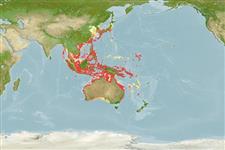>
Acanthuriformes (Surgeonfishes) >
Siganidae (Rabbitfishes)
Etymology: Siganus: Latin, siganus = a fish, rabbit fish; by the similarity of the nose (Ref. 45335).
Environment: milieu / climate zone / depth range / distribution range
Οικολογία
Θαλασσινό(ά); Υφάλμυρο Υφαλόφιλο(α); ωκεανόδρομο(ς) (Ref. 51243); εύρος βάθους 1 - 50 m (Ref. 9813). Tropical; 42°N - 37°S, 90°E - 171°E
Western Pacific: southern Korea, southern Japan, Ogasawara Islands, Taiwan, southern China, Malaysia, Singapore, Thailand, Andaman Islands, Indonesia, Philippines, Yap, Palau, Pohnpei (Caroline Islands), Solomon Islands, Papua New Guinea, Vanuatu, New Caledonia, and Australia. Often misidentified as Siganus canaliculatus (Ref. 2334).
Length at first maturity / Μέγεθος / Βάρος / Age
Maturity: Lm 5.6 range ? - ? cm
Max length : 40.0 cm TL αρσενικό/απροσδιόριστο; (Ref. 9813); common length : 25.0 cm TL αρσενικό/απροσδιόριστο; (Ref. 9813)
Ραχιαίες άκανθες (συνολικά) : 13; Μαλακές ραχιαίες ακτίνες (συνολικά) : 10; Εδρικές άκανθες: 7; Μαλακές εδρικές ακτίνες: 9; Σπόνδυλοι: 13. Body olive green or brown above, silvery below; fish frequently with a dark patch below origin of lateral line. Adults become mottled when frightened. Slender, pungent, venomous spines. Preopercular angle 89°-95°. Lower half to 2/3 of cheeks commonly covered with weak, scattered scales. Midline of thorax between pelvic ridges. Differs from S. argenteus in details of coloration and less deeply forked tail (Ref. 37816).
Inhabits algal and seagrass flats and shallow lagoon and coastal reefs (Ref. 9710, 11230). Forms schools. Mainly diurnal. Juveniles feed on filamentous algae, adults feed on leafy algae and seagrasses (Ref. 9710). Commercially cultured in Japan. Commonly found in large estuaries (Ref. 9002). Anterolateral glandular groove with venom gland (Ref. 57406).
In Belau, ripe individuals form prespawning congregations of 30-60 individuals in shoal areas of inner reef flats; spawning occurs on the 4th or 5th day of the new moon; spawning sites are near reef edge. About 300,000 eggs/female at a single spawning. Individuals that spawn in consecutive yrs. & that 2+ yr. class fish could spawn more than once in a single season. Aug (Ref 1754) in Belau.
Woodland, D.J., 1990. Revision of the fish family Siganidae with descriptions of two new species and comments on distribution and biology. Indo-Pac. Fish. (19):136 p. (Ref. 1419)
IUCN Red List Status (Ref. 130435)
Human uses
αλιεία: Εμπορικό(ά); Υδατοκαλλιέργειες: Εμπορικό(ά)
Εργαλεία
Special reports
Download XML
Διαδικτυακές πηγές
Estimates based on models
Preferred temperature (Ref.
123201): 22.6 - 29, mean 27.9 °C (based on 760 cells).
Phylogenetic diversity index (Ref.
82804): PD
50 = 0.5000 [Uniqueness, from 0.5 = low to 2.0 = high].
Bayesian length-weight: a=0.01288 (0.00826 - 0.02009), b=2.99 (2.86 - 3.12), in cm total length, based on LWR estimates for this species & Genus-body shape (Ref.
93245).
Τροφικό Επίπεδο (Ref.
69278): 2.0 ±0.1 se; based on diet studies.
Generation time: 1.3 ( na - na) years. Estimated as median ln(3)/K based on 1
growth studies.
Ελαστικότητα (Ref.
120179): Υψηλό, ελάχιστος χρόνος για διπλασιασμό πληθυσμού < 15 μήνες (Preliminary K or Fecundity.).
Fishing Vulnerability (Ref.
59153): Low vulnerability (21 of 100).
Nutrients (Ref.
124155): Calcium = 36.7 [18.1, 83.9] mg/100g; Iron = 0.709 [0.352, 1.481] mg/100g; Protein = 19.2 [17.9, 20.4] %; Omega3 = 0.145 [0.082, 0.262] g/100g; Selenium = 24.8 [10.9, 52.7] μg/100g; VitaminA = 34.4 [9.7, 114.8] μg/100g; Zinc = 1.8 [0.7, 3.5] mg/100g (wet weight); based on
nutrient studies.
